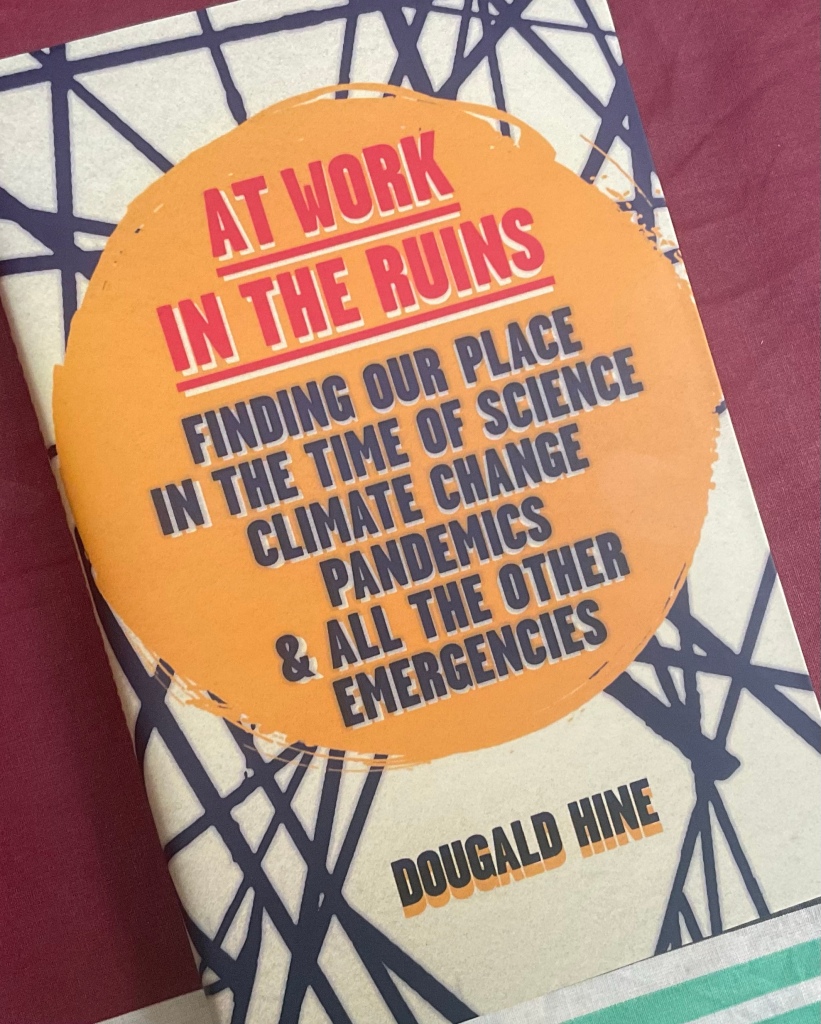The writer Dougald Hine is currently on a speaking and meeting tour of the UK to talk about his new book At Work in the Ruins, published yesterday. Time was that I might have also called Dougald ‘a climate campaigner’, but reading—so far—the first couple of chapters it could have been subtitled, ‘Why I am no longer talking about climate’, rather than the subtitle preferred by the publishers, which was the more nuanced and SEO-richer ‘Finding our place in the time of science, climate change, pandemics, & all the other emergencies.’

(Photo: Andrew Curry, CC BY-NC-SA 4.0)
Anyway, during the course of the week Dougald has published both an extract from the actual introduction to the book, and an extract from a section that he later discarded. This sort of thing is catnip to writers, so I’m going to include some extracts from both here. Here’s one from the published book. For, if we are sitting in the ruins, we need to know what it is that is ending, and that it will end. The extract starts with a quote from Ben Okri:
‘In these times, all we can do is be a sign,’ a father tells his daughter in Ben Okri’s novel The Freedom Artist. ‘We have to help to bring about the end of the world.’ We must do this, he goes on, so that a new beginning can come. ‘But first there must be an end.’
Hospicing
But many ends are possible. One of the problems of reading books like this is that it points you to other books, and I was immediately attracted by the title of Vanessa Machado de Oliveira’s book Hospicing Modernity:
The title invites us to a kind of work in which the focus is not on saving modernity, or bringing it down, or rushing to build what comes afterwards, but doing what we can to give it a good ending. To let it hand on its gifts and teach the lessons that may only become apparent as the end approaches… No one I’ve met has more to offer by way of tools for the work of hospicing, but the way Vanessa tells it, this must be accompanied by a work of midwifery: assisting with the birth of something new, unfamiliar and possibly (but not necessarily) wiser.
In a similar vein he also quotes the philosopher Federico Campagna, who also talks of living at the end of a world.
In such a time, he suggests, the work is no longer to concern ourselves with making sense according to the logic of the world that is ending, but to leave good ruins, clues and starting points for those who come after, that they may use in building a world that is – as Vanessa would say – ‘presently unimaginable’.
Good ruins
All of this resonated with me because when I explain how the Three Horizons framework works, I often use a quote from the American politician John Vasconcellos, which I learned from the work of Graham Leicester:
We need to be hospice workers for the dying culture and midwives for the new.
I also liked the idea of ‘good ruins, clues and starting points’, which spoke to me of a certain humility in imagining how future generations might want to shape the world they inherit from us.
The introduction that didn’t get used—his editor proposed that he cut it, and Hine accepted the suggestion—was more sweeping, big picture history, flashing past the Aztecs and Hindu mythology to land in a Europe that had found science and lost its mythos:
History is written by the victors, but their memories are short. ‘Preindustrial Europe had little that was in demand by the rest of the world,’ Sven Lindqvist points out. ‘Our most important export was violence. All over the rest of the world, we were seen as nomadic warriors in the manner of the Mongols or the Tartars. They ruled from the backs of horses, we from the decks of ships.’… (W)hen our ship-borne warriors crossed the horizon into other people’s worlds, we were the barbarians.
Europeans
It’s a version of that world that is ending now, and there’s a passage in this unused introduction that connects the fate of many cultures when they met those Europeans with the fate that we can see for ourselves now. This, at least, is the observation of the anthropologists Mario Blaser and Marisol de la Cadena, in their book, A World of Many Worlds.
The world of the powerful is now sensitive to the plausibility of its own destruction in a way that may compare, at least in some ways, with the threat imposed on worlds sentenced to disappearance in the name of the common goods of progress, civilization, development, and liberal inclusion.
Or, as Hine summarises:
We went around the world, ending other people’s worlds and calling it progress, and now it dawns on us that our world too could end.
Narrative sweep
He says of this unused piece that he’s glad the editor made this suggestion, because the big narrative sweep did not sit well with the rest of the book, which is more intimate, “a story told from a particular place and time, shaped by personal experiences”. All the same, Blaser and de la Cadena’s idea remains central to the narrative of At Work in the Ruins, and he says that A World of Many Worlds made the deepest impression on him in his work on his book. (Another one for the reading list, perhaps).
One of the reasons for this is that they describe a fork in the road that follows from the realisation that one’s world is ending, especially when that world has been used to terraforming lands and cultures into its own likeness:
it can be a humbling moment, brought down to earth and able to hear at last what those on the receiving end of Western projects of colonisation, salvation, modernisation and development have been trying to tell us for generations. Or it can be the licence for the grandest version of that project yet: an attempt to turn our planetary home and all those we share it with, our human kin and our more-than-human kith, into an object of global management and control.
Decline
There needs to be an ending. One of my continuing touchpoints in all of this is the base case of The Limits to Growth (in this case the 30th anniversary edition) in which global industrial production per capita stagnates and then declines at some time in the 2020s, and global population starts to decline sometime in the 2030s. It’s the base case because it assumes our behaviour as a species doesn’t change. In their model, technology doesn’t help here: it delays the crash, but the crash, when it comes, is faster and harder.
And what I take from this is that we don’t get to choose whether or not there is an ending. We only get to choose what kind of ending we have, and therefore what we have left to build from.
——-
This article was also published on my Just Two Things Newsletter
Teaser photo credit: 1906 San Francisco earthquake: Ruins in vicinity of Post and Grant Avenue.. By Chadwick, H. D – This tag does not indicate the copyright status of the attached work. A normal copyright tag is still required. See Commons:Licensing., Public Domain, https://commons.wikimedia.org/w/index.php?curid=2128556





